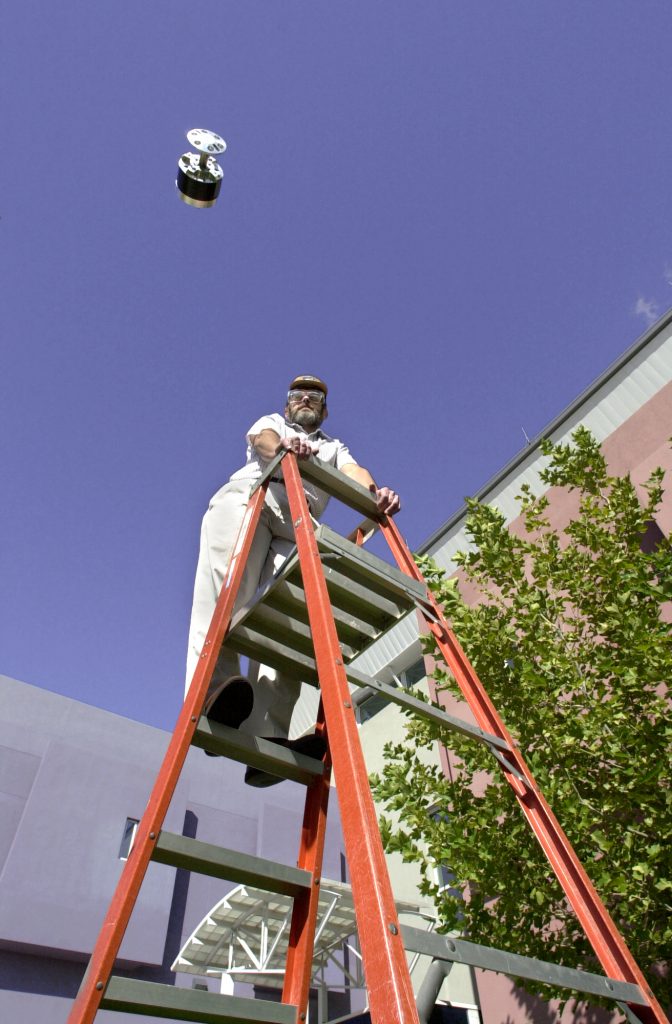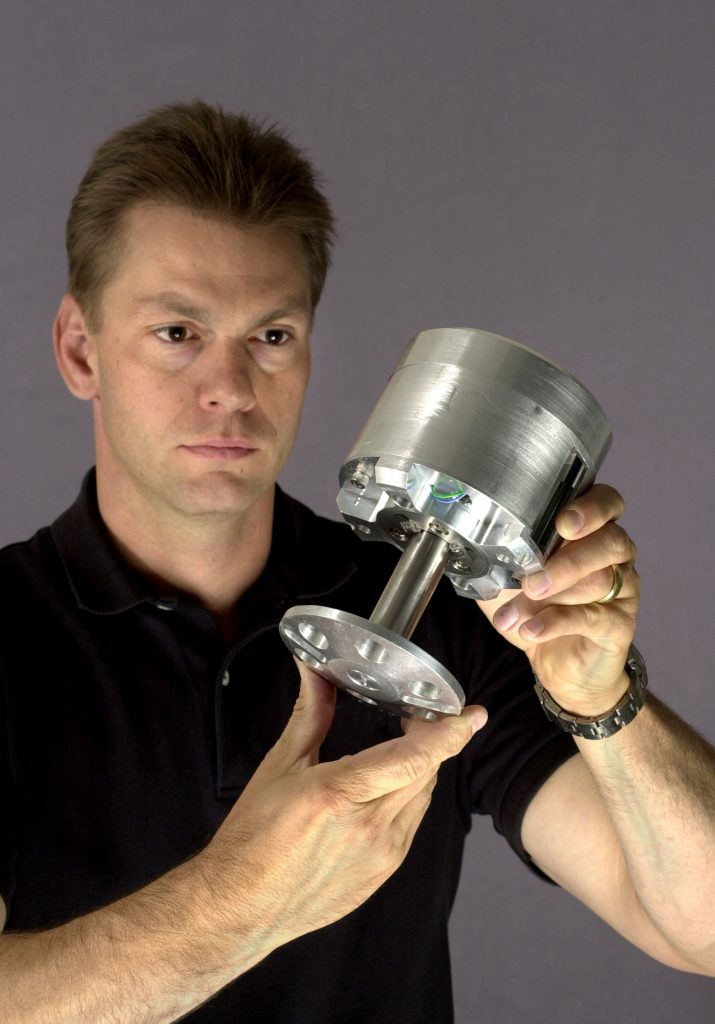
Download 300dpi JPEG image, ‘HighHopper.jpg’, 1MB (Media are welcome to download/publish this image with related news stories.)
ALBUQUERQUE, N.M. — Hopping machines inspired by the clumsy jumping of grasshoppers may soon give robots unprecedented mobility for exploring other planets, gathering war-fighting intelligence, and assisting police during standoffs or surveillance operations.
The unique robots, developed by researchers at the Department of Energy’s Sandia National Laboratories, use combustion-driven pistons to make leaps as high as 20 feet. The work is funded by the Defense Advanced Research Projects Agency (DARPA).
Other mobile robots use wheels, treads like those on tanks, or insect-like legs to get over and around obstacles. Some are operated remotely by a person who can steer the robot clear of impediments. But reliable, autonomous mobility in difficult environments has eluded robot engineers and complicated planned planetary exploration missions.
Rush Robinett of Sandia’s Intelligent Systems and Robotics Center (ISRC) conceived the idea of a hopping robot as he was catching grasshoppers to use for trout fishing. “I noticed they jump around in a random fashion, hit the ground in an arbitrary orientation, right themselves, and jump again,” he says. “I said to myself: ‘I can make a robot do that.’”
But making the idea work wasn’t easy. Others had tried jumpers using electrically actuated springs and other methods, but the energy required for a leap that could at least clear the robot’s own height was too great, and batteries wouldn’t last long enough for long-range missions.
ISRC senior scientist Barry Spletzer suggested that because hydrocarbon fuels provide much greater energy densities (energy per unit of volume) than batteries, a small combustion-powered hopper theoretically could travel greater distances and clear larger obstacles.
In 1997 DARPA asked Sandia to create a hopping robotic platform for military reconnaissance applications.
“Most mobile robots are designed to steer directly to a spot very efficiently,” says Spletzer. “But over long distances you don’t need that kind of precision. With a hopper you have time to make corrections after each jump, so it doesn’t need to steer while it’s the air. Once we determined that semi-random mobility was OK, we knew a hopper was possible.”

Download 300dpi JPEG image, ‘GFhopper.jpg’, 1.4MB (Media are welcome to download/publish this image with related news stories.)
One Sandia hopping robot is contained inside a grapefruit-sized plastic shell shaped something like the children’s toy Weeble®, so the hopper rights itself after each jump — piston toward the ground but slightly askew. A pre-programmed microprocessor inside the hopper reads an internal compass, and a gimbal mechanism rotates the offset-weighted internal workings so that the hopper rolls around until it is pointed in the desired direction.
The combustion chamber fires, the piston punches the ground, and the hopper leaps.
The hopper jumps about 3 feet in the air and 6 feet from its starting point on each jump and, theoretically, could last about 4,000 hops on a single tank of gas, which is about 20 grams of fuel. Each hopping cycle is about 5 seconds.
Another hopper, about the size of a coffee can, jumps 10 to 20 feet in the air and theoretically could go 100 hops on a tank of fuel.
Several patents are pending on the inventions.
“We spent a long time getting here,” says the ISRC’s Gary Fischer, who developed the robot’s unique internal combustion engine that makes it hop. “It wasn’t easy.”
Recalling his youthful experience launching tennis balls out of a tube using lighter fluid, Fischer first suggested that evaporated fuels might provide power needed for high hops.
At one point the Sandia research team had set a goal of simply achieving atmospheric combustion in a small piston chamber. The first “jumps” did nothing more than topple the robot.
“Our first jumps were weak because we were looking for the correct fuel mixtures and spark energies to achieve ignition,” he says. “When we finally made it fall over, we were happy.”

Download 300dpi JPEG image, ‘LowHopper.jpg’, 1MB (Media are welcome to download/publish this image with related news stories.)
Later the team tried maximizing the power of the piston, ultimately achieving hops higher than 30 feet. “When we did that we knew we were on to something,” he says.
The research team now is working on a hopper that can be controlled remotely using a joystick, as well as hoppers with shock-absorbing rubber shells that can land on concrete.
Because the hopper is lightweight and could be inexpensive to produce, Spletzer foresees a variety of worldly uses for hoppers.
“You’d like a robot that Marines or SWAT teams could toss into a second story window, then hop it around for a look inside,” says Spletzer. “That could save lives.”
“But where we want to go is Mars and the moon,” he says. “With a hopper, you could go much farther from the lander. You could throw out a dozen of these to search in all directions.”
Sandia’s Intelligent Systems and Robotics Center provides practical, reliable automation solutions for unstructured or highly variable settings. The Center’s focus is developing automation systems that are cost-effective regardless of whether the customer needs to produce 10 or 10,000 items. (For more information, see www.sandia.gov/isrc/.)